| Columns Retired Columns & Blogs |
Thiel CS2.4 loudspeaker Measurements
Sidebar 3: Measurements
I estimated the Thiel CS2.4's voltage sensitivity to be slightly higher than both average and specification, at 88dB(B)/2.83V/m. However, despite Wes Phillips' conjecture that this speaker is not too hard to drive, its impedance plot (fig.1) indicates that the CS2.4 demands a lot of current from amplifiers. Not only does its impedance drop to 2.73 ohms at 600Hz, but it stays significantly below 4 ohms from 100Hz to 50kHz, and there is a difficult combination of 4.5 ohms magnitude and –45° electrical phase angle at 80Hz. Thiel CS2.4 owners should make sure they have a good 4 ohm–rated amplifier to drive this speaker.
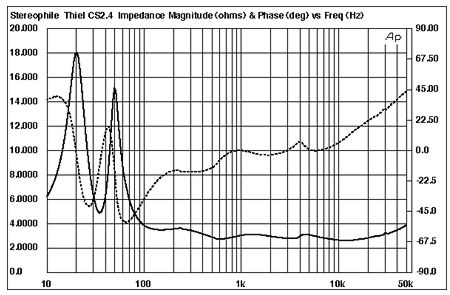
Fig.1 Thiel CS2.4, electrical impedance (solid) and phase (dashed). (2 ohms/vertical div.)
The traces in fig.1 are free from the small discontinuities that would indicate the presence of enclosure resonances. Even so, I found a resonant mode present at 281Hz on the side panel, as well as some other, low-level modes higher in frequency (fig.2). As WP didn't comment on any midrange congestion, it's entirely possible that this behavior looks worse than it sounds.
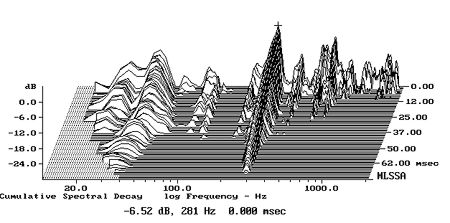
Fig.2 Thiel CS2.4, cumulative spectral-decay plot calculated from the output of an accelerometer fastened to the center of the cabinet's side panel 12" from base (MLS driving voltage to speaker, 7.55V; measurement bandwidth, 2kHz).
The saddle at 35Hz in the impedance-magnitude trace implies that this is the tuning frequency of the CS2.4's passive radiator (which behaves in the same manner as the slug of air in a reflex design's port). As expected, the woofer's nearfield response features a notch at this frequency (fig.3, blue trace), which is when the back pressure from the port or radiator resonance holds the woofer cone still. The passive radiator's output peaks at the same frequency (fig.3, red trace). Though its 12dB/octave high-frequency rollout is marred by some slight peaks, these may well be sufficiently low in level to have no subjective consequences. The Thiel's overall low-frequency response is plotted in black in fig.3; some of the apparent low-frequency boost will be due to the nearfield measurement technique, but there is still a little too much bass in absolute terms—as Wes pointed out, the speaker's balance is rich. But note the excellent LF extension apparent in this graph, with useful output available down to 30Hz.
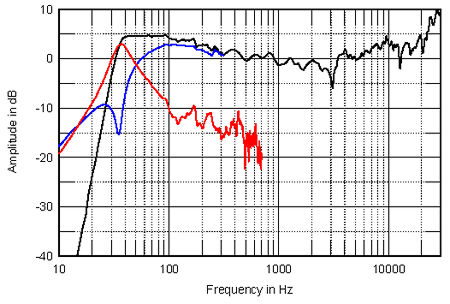
Fig.3 Thiel CS2.4, anechoic response on tweeter axis at 50", averaged across 30° horizontal window and corrected for microphone response, with the nearfield responses of woofer (blue) and port (red), plotted below 300Hz and 700Hz, respectively, and the complex sum of the nearfield woofer and port responses, taking into account acoustic phase and distance from the nominal farfield point, plotted below 300Hz (black).
Higher in frequency, the CS2.4 is basically flat on-axis throughout the midrange and low treble. However, there is a discontinuity at 3kHz, which is just about where the small midrange unit crosses over to the coaxial tweeter, followed by a somewhat shelved-up (2–3dB) high treble. The speaker's output continues to rise above the audioband, reaching +10dB at the 30kHz limit of this graph. (This measurement was made with a calibrated DPA 4006 microphone; I double-checked the speaker's ultrasonic behavior with an EarthWorks QTC-40 mike, which has flat response up to 40kHz.) WP did find the CS2.4's presentation "crisp," though he felt the Thiel had less HF extension, less HF "air," than the Peak Consult Empress, which he reviewed in October, despite the Empress's having less measured on-axis energy in the treble. Perhaps this was due to the tube amplifiers he was using some of the time. In my own auditioning of the CS2.4 (in mono) with solid-state amplification, I was aware of its shelved-up top octaves, though they didn't sound unnatural. I suspect that, subjectively, the treble is balanced by the CS2.4's powerful bass.
Turning to the Thiel's dispersion, the horizontal radiation pattern on the tweeter axis (fig.4) reveals that the on-axis glitch in the crossover region fills in to the speaker's sides, while the tweeter's off-axis output drops rapidly above 20kHz. However, a lack of energy develops at around 1kHz, which might make the speaker sound both a little reticent and bright in overly reverberant rooms. In the vertical plane (fig.5), the presence-region notch in the tweeter-axis response does fill in for ear heights a few inches below that axis (already a low 32.5" from the floor). Sit with your ears above the tweeter, however, and the same lack of energy in the 1kHz region as seen in the horizontal dispersion plot makes an appearance. The use of widely spaced drive-units and first-order crossover filters makes this behavior inevitable, however.
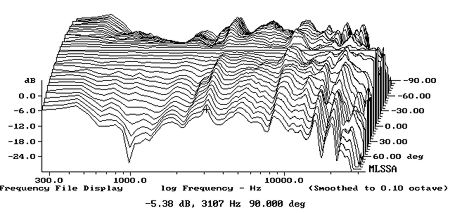
Fig.4 Thiel CS2.4, lateral response family at 50", normalized to response on tweeter axis, from back to front: differences in response 90–5° off axis, reference response, differences in response 5–90° off axis.
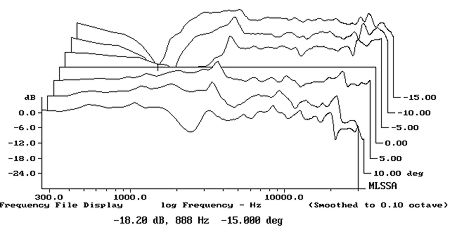
Fig.5 Thiel CS2.4, vertical response family at 50", normalized to response on tweeter axis, from back to front: differences in response 15–5° above axis, reference response, differences in response 5–15° below axis.
The tradeoff is that the speaker's behavior is optimized in the time domain. The CS2.4's step response (fig.6) has almost a perfect right-triangle shape with just a small amount of leading-edge overshoot apparent, this correlating with the shelved-up top octaves seen in the frequency response. The cumulative spectral-decay plot (fig.7) is very clean in the midrange and low treble, but is marred by what appear to be ridges of delayed energy in the mid- and high treble. I believe that this doesn't reveal resonances so much as interference effects from the coaxial midrange/treble driver.
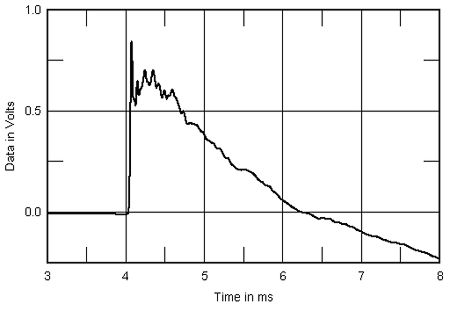
Fig.6 Thiel CS2.4, step response on tweeter axis at 50" (5ms time window, 30kHz bandwidth).
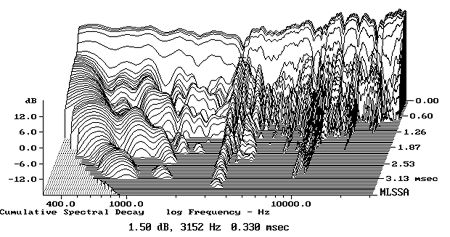
Fig.7 Thiel CS2.4, cumulative spectral-decay plot at 50" (0.15ms risetime).
Overall, the Thiel CS2.4 offers pretty good measured performance, its few idiosyncrasies resulting from the designer's use of a first-order crossover between the woofer and midrange unit.—John Atkinson
- Log in or register to post comments




































